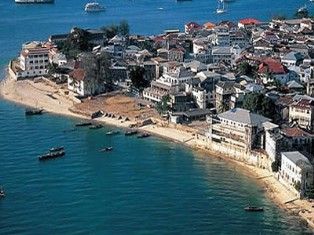Zanzibar Introduction
Zanzibar, or ‘Unguja’ –the spice island beckons you to its golden shores, warm smiles and delectable cuisine. An island with a history dating back to as early as 1st century AD, when Greek and Roman ships sailed along the East Coast of Africa. Centuries later saw a succession of Arab, Persian, Portuguese and African traders all searching for ivory, tortoiseshell, ebony, coconuts, fruit, timber and of course slave trading.
The British government still maintains a residence in Zanzibar, Hamerton House. It is located between Zanzibar Town and the airport, on a cliff overlooking the Indian Ocean. Hamerton House is used every now and then by the British High Commissioner in Dar es Salaam and/or his staff members, when they are on official duty in Zanzibar. It is also used in case of consular contingencies.
Geographically, Zanzibar’s location made it a viable commercial centre for trading through the centuries and as a result we see a wide array of architecture reflecting her history. It was once a separate state with a long trading history within the Arab world; it united with Tanganyika to form Tanzania, but still enjoys a high degree of autonomy within the union. Zanzibar has its own Revolutionary Council and House of Representatives (with 50 seats, directly elected by universal suffrage to serve five-year terms) to make laws especially for it; these make up the semi-autonomous Revolutionary Government of Zanzibar.
Famous for its clove tree plantations Zanzibar also produces sesame seed, coconut oils, sugar and rubber, which are predominantly exported. Famous explorers such as Stanley, Livingstone, Burton, Elton visited




Zanzibar at various stages of their explorations.
The inhabitants of Zanzibar speak KiSwahili and fall into three ethnic groups, the Wahadimu, the Watumbatu and the Wapemba and relations between the various clans or tribes is very relaxed.
Zanzibar Archipelago consists of two islands, one being actual Zanzibar and the other Pemba. Zanzibar is approximately 85 km long and 30 km wide with area of 1500 km. Pemba lies to the north and is 75 km long and 20 km wide with an area of 850 km. Although not too far from each other (50 minutes by air) and 2 hours by boat, they have different climates and vegetation.
Like most other Indian Ocean Islands, the monsoon season begins in early March end continues until the end of May and then again in November but for the rest of the year hot sunny temperatures are the norm, ranging from 26 – 28 C (80 – 83F). Pemba is slightly cooler and receives more rainfall than her big sister. Both islands boast world-class beaches, opal colored seas plus a choice of luxury and budget hotels to suit all tastes plus easy access, whether it be by air or by ferry.
World famous for diving and snorkelling these seas offer unspoilt coral reefs with a variety of marine life including whales, dolphins, dugongs and big game fish – it just doesn’t get any better than this! Don’t forget to visit Misali Island – a hop and a skip from Fundu Lagoon on Pemba Island.
Far South of Zanzibar lies the island of Mafia – another golden island basking in sunshine and welcoming weary travellers. The only means of getting to Mafia is by private aircraft. Farming and fishing are traditional means of income and with the increase in tourism you will see traditional basket weavers, tinga tinga painters, colourful khangas, plus their famous spices being sold everywhere.
For night owls, the capital Stone Town is a bustling harbour town with much to offer – fine restaurants serving local fare including Asian, Arabic, European and Western cuisine – you won’t be left hungry. For the enthusiast dancer why not visit the local nightclubs and absorb yourself in the vibrant music of Zanzibar. Take a stroll down the main shopping streets and see the vendors plying their wares above the noise of the traffic, music carts and bustle of people – a colourful experience not to be missed. Leaving Stone Town, heading North, South or East, life is slower and more rural than the city. The coastal roads are in dire need of maintenance but this is all soon forgotten once you arrive at your beach destination.
Car rental is not recommended at all for the time being but we do offer reliable and comfortable transfers throughout.
Visas: If required can be issued on arrival in Dar-es-Salaam or Zanzibar (approximately USD60). However, if you are transiting through Dar on your way to Zanzibar you will be required to pass through immigration in Dar in which case you will need to get your visa here.If your transit time is very short then it is advisable to get your visa prior to departure as you may miss your connecting flight.
Currency: Tanzanian Shilling (TSh). Euro and USDollars cash are widely accepted but payments at all hotels must be in foreign exchange. Surcharges are applicable at all hotels for credit cards and traveller’s cheque payments and only Visa / MasterCard are accepted.
Health: Yellow fever vaccination certificate compulsory. Malaria high risk. It is not advisable to drink tap water. Bottled water sold everywhere. IMPORTANT – If you are travelling from a yellow-fever endemic area to South Africa, immigration officials may ask you for proof of your current Yellow Fever vaccination. It is important to keep this vaccination up to date and to keep it with you when travelling abroad. Be aware that the vaccination only becomes valid 10 days after inoculation and is valid for 10 years.
Language: English widely spoken and Italian understood. Kiswahili is the official language.
Time: GMT+ 3
Climate: Tropical climate dominated by the Indian Ocean monsoons. The Kaskazi winds from the north bring the short rains in November and December. The long rains known as Mwaka, arrive in April and last until late May. January-March is hot and dry with little rainfall. July-October are ideal months to visit with average temperatures of 25 C.
Clothing: Should be respectful. Ladies should cover their shoulders, knees and midriff. Please take diving booties or plastic beach shoes to the coast as the reefs have sea urchins. For the cooler temperatures take something with long sleeves for the evenings. The beach resorts do not have a strict dress code but topless bathing is illegal.
Power Supply: 230v, 3 prong square (like UK) and 3-pin round triangular plugs (not South African size).
Customs Allowance: 1 bottle of wine or spirits, 200 cigarettes or 50 cigars or 250 grams of tobacco.
Luggage Allowance: International flights: 20 kg and regional flights: 15 kg per passenger
Shopping: Shops are closed from 12h00 till 14h00 on most days and mornings on Fridays to respect the Muslim culture.
Photography: It is prohibited to film airports, military institutions and some ladies do not like photos – if you wish to take a photo please ask first.
Reading material: Guide to Zanzibar by Bradt Publications.
Pemba Island Introduction
Pemba Island is the northernmost island of the archipelago. Pemba Island is still a major clove producer, but has now slipped into a more traditional role of being an island paradise with small inter-island trade. Chake wharf is now mainly used for swimming & fishing.
Pemba was seized by the Sultan of Muscat (now Oman) in the 17th century. He was so enchanted by the Spice Islands that he installed himself in Zanzibar and ruled Muscat from there. When the Western Colonial powers came to East Africa the British forced the Sultanates of Muscat and Zanzibar to separate and then administered the Spice Islands in the name of the Sultan. All the while, the Arab dhows would ply the trade winds down from the Arabian Peninsula to East Africa. With the winds they would take cloves to India, textiles back to the Arab lands and silver and wood to the Spice Islands of Unguja and Pemba.
The Dhows have remained a constant throughout the history of Pemba. To this day they ply the run from Wete to Shimoni in Kenya and, when the winds are favourable they plough through to Northern Mozambique.
Pemba is a magical island. Unlike Unguja, Pemba is hilly. Gentle, undulating hills and deep verdant valleys are all covered with a dense cover of clove, coconut and mango plantations. A more fertile land it is difficult to imagine then Pemba. But it is not just the landscape that gives Pemba its magical reputation. For centuries Pemba has held a reputation as a centre for the juju traditions of medicine and magic.
